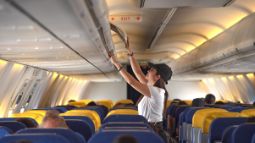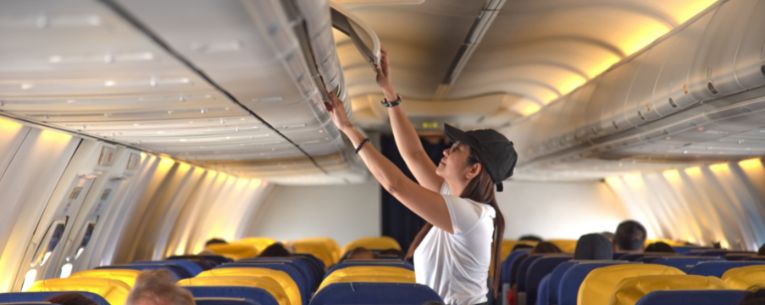There is something that’s simply freeing about traveling light. When you can stuff everything you need into a carry-on bag and skip past the baggage claim carousel, you’re traveling untethered from worries, cares, or that behemoth metal suitcase without wheels that Great Aunt Sally offered to let you borrow for the trip.
There are a number of reasons to considering packing everything in your carry-on bag. Take convenience; one less thing to lug and drag around airports and hotels is one less thing to forget. (And don’t forget the 73 socks, blazers and belts packed in that one suitcase.)
Then there are the time savings of not having to wait awkwardly at the baggage check for your bag to emerge from the Rotating Oval of Chance. That’s right, sometimes when you make your connecting flight to Rochester, N.Y., your bag is sent to Rochester, Minn.
Lost bags can sink your trip — separating you from clothes, accessories, and mission critical items while adding unexpected costs. Unplanned business suit or bathing suit shopping trips aren’t cheap, quick, or easy. This scenario, combined with the frequency at which bags are lost or delayed, makes a travel insurance plan from Allianz Partners a must-have. Imagine getting reimbursed for covered expenses resulting from a lost or delayed bag — as well as protecting that designer, monogrammed suitcase that’s stranded on the tarmac in Albuquerque — forever. Before you read on, take a moment to find the travel insurance plan that’s right for your itinerary and budget.
No matter what your reasoning is for packing all you need for a trip in one carry-on bag, from a weekend getaway to a weeklong jaunt around the Australian Outback, we have some tips for fitting your life into 45-ish linear inches of space.
How Much Time & Money Do Carry-Ons Really Cost?
Inflation has spread to baggage fees — and we’re not just talking about trying to squeeze some souvenir T-shirts into your suitcase on the return trip without the zipper popping off like a Champagne cork. The average cost of a first checked bag has ballooned from $25 to $40 over the past 5 years. And they can more than triple when you get to that third checked bag.1
Of course, time is money, too. And on average you’ll spend anywhere from 15 to 45 min. waiting for your checked bags to emerge on the conveyer belt.2 (Fun fact: Delta promises to get you your bag within 20 minutes. And if they don’t, they’ll give you a pocketful of bonus miles.)3
It may be tough to put a price on your time, but consider all the travelers with carry-ons only who got in the taxi line or virtual Uber or Lyft queue before you. They could be kicking back by the hotel pool with a happy hour margarita while you’re sitting on the concourse sidewalk with a crowd of wary travelers trying to win the ride-share lottery.
How Much Space Will Your Carry-On Bag Provide?
First off, when we talk about fitting all you need for a trip into a carry-on bag, we’re not necessarily talking about just one bag. That’s because many airlines allow you to bring a personal item on board in addition to your carry-on, which may include a purse, messenger or shoulder bag, laptop bag or briefcase, or backpack.
Now let’s talk about the carry-on bag. The maximum size of the bag can vary, but as stated above this is usually about 45 inches as a linear measurement with a maximum weight ranging from 11 lbs. on Bangkok Airways to 51 lbs. on British Airways. Many airlines break down the dimensions as “Height X Width X Depth;” you can add them together to get the linear measurement. Or you can simply try fitting your bag into the sizing contraptions airlines often place by the terminal gates. (This handy carry-on bag sizing chart provides all the specific dimensions by the airline you should ever need.)4
Structured Carry-On Bag Vs. Soft-Sided Bag
Go to the airport and eyeball the folks who are obviously experienced travelers. (Think of George Clooney’s jet-setting, miles-obsessed character from “Up in the Air.”) These fliers always have the roller bag style of suitcase, which is a structured, often hard-sided bag that offers a protective rectangular shell of storage.
These are popular, reliable bags — but they’re not always ideal for getting the most out of your storage space. Duffel bags and other soft-sided luggage are much more flexible, bending without breaking as you stuff in an extra pair of socks or some last-minute souvenirs. Sure, the protection is inferior to those harder roller bags, but just keep all the delicate items on the inside, surrounding them with layers of clothes.5
How to Pack Your Carry-On Bag for Maximum Space
Once you’ve made the decision to only bring a carry-on bag to the airport, you need to have a better plan that simply throwing everything in the bag and hoping it fits. Here are some tried and true tips for making it work.
- Skip the liquids and gels, at least as many as you can get away with. Instead, buy trial-size personal care items when you arrive. And toss them before you fly back.
- Wear your bulkiest, heaviest clothes on the flight. This is easier said than done when it’s August in New Orleans, but it just might be jeans, sweater and blazer weather for you. (A company called Jaktogodesigns “wearable” luggage so you can pocket extra t-shirts and belts without sacrificing precious baggage space.)6
- Try limiting your colors so you have a more versatile wardrobe with which you can arrange multiple outfits with just a few key items.
- Store items inside items: socks inside shoes, phone chargers inside socks, etc. You get the picture.5
- Air costs you space. So suck it up. No, seriously. They go by many names, from compressions bags to space savers, but these plastic travel bags allow you to remove extra air from inside them, either manually or with the aid of a vacuum cleaner, to fit more stuff.
These are just a few methods for optimizing your limited storage space when you’re traveling without any checked bags.
At the end of the day, it really comes down to picking the right trip to fly with just a carry-on bag. If you’re getting away for the weekend and don’t want the literal or figurative weight of a checked bag, you can pull it off with a little planning. But if you have a one-way ticket to a destination you’ve never been to that’s halfway around the globe, You’ll probably want to check a bag — or three.
Related Articles








Share this Page